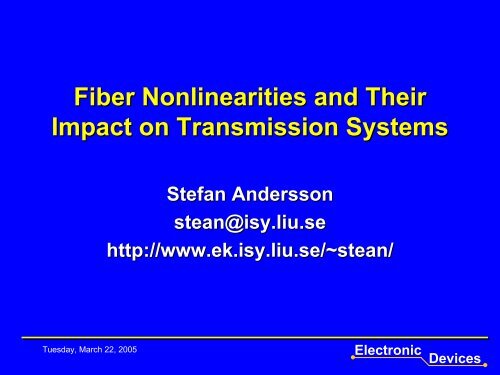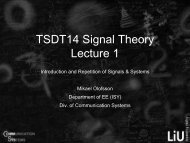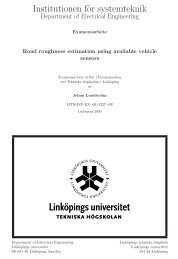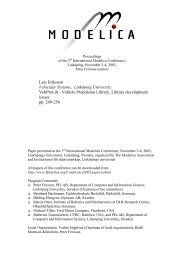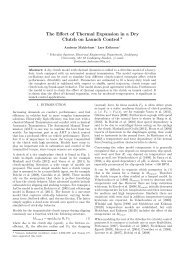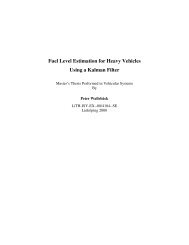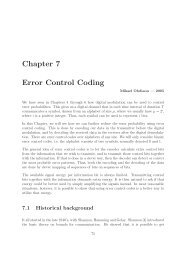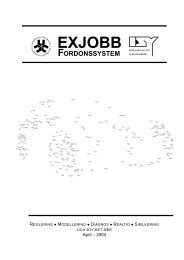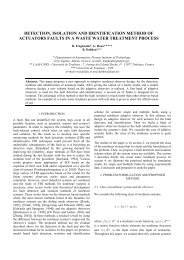Fiber Nonlinearities and Their Impact on Transmission Systems
Fiber Nonlinearities and Their Impact on Transmission Systems
Fiber Nonlinearities and Their Impact on Transmission Systems
You also want an ePaper? Increase the reach of your titles
YUMPU automatically turns print PDFs into web optimized ePapers that Google loves.
<str<strong>on</strong>g>Fiber</str<strong>on</strong>g> <str<strong>on</strong>g>N<strong>on</strong>linearities</str<strong>on</strong>g> <str<strong>on</strong>g>and</str<strong>on</strong>g> <str<strong>on</strong>g>Their</str<strong>on</strong>g><br />
<str<strong>on</strong>g>Impact</str<strong>on</strong>g> <strong>on</strong> Transmissi<strong>on</strong> <strong>Systems</strong><br />
Stefan Anderss<strong>on</strong><br />
stean@isy.liu.se<br />
http://www.ek.isy.liu.se<br />
www.ek.isy.liu.se/~stean/<br />
Tuesday, March 22, 2005<br />
Electr<strong>on</strong>ic Devices
Outline<br />
• Introducti<strong>on</strong><br />
• An Overview of <str<strong>on</strong>g>Fiber</str<strong>on</strong>g> <str<strong>on</strong>g>N<strong>on</strong>linearities</str<strong>on</strong>g><br />
• Stimulated Brillouin Scattering (SBS)<br />
• Self-Phase Modulati<strong>on</strong> (SPM)<br />
• Cross-Phase Modulati<strong>on</strong> (CPM)<br />
• Four-Phot<strong>on</strong> Mixing (FPM)<br />
• Dispersi<strong>on</strong> Management<br />
• Modulati<strong>on</strong> Instability (MI)<br />
• Stimulated Raman Scattering (SRS)<br />
• Scaling <str<strong>on</strong>g>N<strong>on</strong>linearities</str<strong>on</strong>g><br />
• Summary<br />
Tuesday, March 22, 2005<br />
2(32)
Introducti<strong>on</strong><br />
• <str<strong>on</strong>g>Fiber</str<strong>on</strong>g> n<strong>on</strong>linearities becomes a problem<br />
when several channels coexist in the<br />
same fiber (WDM=Wavelength Divisi<strong>on</strong><br />
Multiplexing)<br />
• Interacti<strong>on</strong>s between propagating light<br />
<str<strong>on</strong>g>and</str<strong>on</strong>g> the fiber can lead to interference,<br />
distorti<strong>on</strong>, or excess attenuati<strong>on</strong> of the<br />
optical signals<br />
• N<strong>on</strong>linear effects are determined by the<br />
total <str<strong>on</strong>g>and</str<strong>on</strong>g> per channel OA output power<br />
Tuesday, March 22, 2005<br />
3(32)
Introducti<strong>on</strong><br />
Tuesday, March 22, 2005<br />
4(32)
Introducti<strong>on</strong><br />
• Chromatic dispersi<strong>on</strong>: Frequency<br />
comp<strong>on</strong>ents of modulated signal travel at<br />
different velocities in fiber<br />
Tuesday, March 22, 2005<br />
5(32)
An Overview of <str<strong>on</strong>g>Fiber</str<strong>on</strong>g> <str<strong>on</strong>g>N<strong>on</strong>linearities</str<strong>on</strong>g><br />
• The n<strong>on</strong>linearities in silica fibers can be<br />
divided into two categories:<br />
1. Stimulated scattering (Brillouin(<br />
<str<strong>on</strong>g>and</str<strong>on</strong>g> Raman),<br />
gives rise to intensity dependent gain or loss<br />
2. Effects arising from the n<strong>on</strong>linear index of<br />
refracti<strong>on</strong>. Gives rise to an intensity dependent<br />
phase of the optical field leading to distorti<strong>on</strong>,<br />
cross modulati<strong>on</strong>, etc.<br />
Tuesday, March 22, 2005<br />
6(32)
An Overview of <str<strong>on</strong>g>Fiber</str<strong>on</strong>g> <str<strong>on</strong>g>N<strong>on</strong>linearities</str<strong>on</strong>g><br />
• N<strong>on</strong>linear interacti<strong>on</strong>s between two signals in a<br />
fiber can be expressed by the change in the<br />
electric field of <strong>on</strong>e of the signals caused by the<br />
other<br />
E ( z + dz)<br />
= E1(<br />
z)exp[(<br />
−α<br />
/ 2 + ik)<br />
dz + gP2<br />
( z)<br />
dz / 2A<br />
1 e<br />
Where α is the loss coefficient, g is the frequency-<br />
dependent gain coefficient of the n<strong>on</strong>linear<br />
process, <str<strong>on</strong>g>and</str<strong>on</strong>g> A e is the effective area of the fiber<br />
• For more complex situati<strong>on</strong>s the n<strong>on</strong>linear<br />
Schrödinger equati<strong>on</strong> needs to be solved<br />
]<br />
Tuesday, March 22, 2005<br />
7(32)
An Overview of <str<strong>on</strong>g>Fiber</str<strong>on</strong>g> <str<strong>on</strong>g>N<strong>on</strong>linearities</str<strong>on</strong>g><br />
• g is real => gain or loss. Parametric<br />
interacti<strong>on</strong> between phot<strong>on</strong>s <str<strong>on</strong>g>and</str<strong>on</strong>g> ph<strong>on</strong><strong>on</strong>s<br />
– Stimulated Brillouin scattering<br />
– Stimulated Raman scattering<br />
• g is imaginary => phase modulati<strong>on</strong>.<br />
Modulati<strong>on</strong> of refractive index by light<br />
intensity fluctuati<strong>on</strong><br />
– Self phase modulati<strong>on</strong> (SPM)<br />
– Cross phase modulati<strong>on</strong> (CPM)<br />
– Four-phot<strong>on</strong> mixing (FPM)<br />
Tuesday, March 22, 2005<br />
8(32)
Stimulated Brillouin Scattering (SBS)<br />
• SBS is caused by interacti<strong>on</strong> of light with<br />
sound waves<br />
• Sound waves in glass cause a variati<strong>on</strong> in<br />
the index of refracti<strong>on</strong><br />
• A str<strong>on</strong>g wave traveling in <strong>on</strong>e directi<strong>on</strong><br />
provides narrow b<str<strong>on</strong>g>and</str<strong>on</strong>g> gain for light<br />
traveling in the opposite directi<strong>on</strong><br />
• The reflected wave experiences a Doppler<br />
shift of about 20MHz in glass<br />
Tuesday, March 22, 2005<br />
9(32)
Stimulated Brillouin Scattering (SBS)<br />
• SBS occurs when the incident light is of<br />
sufficiently high intensity (a few mW)<br />
• The SBS threshold is defined as the input power<br />
at which the scattered power grows as large as<br />
the input power<br />
• System impact:<br />
– When signal power is transferred in a backward directi<strong>on</strong> it<br />
can deplete the forward traveling signal<br />
– The transmitted power grows linearly with input power for<br />
low input powers, but saturates for higher input powers (gain<br />
compressi<strong>on</strong>)<br />
– This limiting behavior is also accompanied by a dramatic<br />
increase in intensity noise<br />
Tuesday, March 22, 2005<br />
10(32)
Stimulated Brillouin Scattering (SBS)<br />
SBS threshold effects<br />
Tuesday, March 22, 2005<br />
11(32)
Self-Phase Modulati<strong>on</strong> (SPM)<br />
• The refracti<strong>on</strong> index of silica is weakly intensity<br />
dependent<br />
P<br />
n n + n ⋅<br />
• n 2 =2.6x10 -20<br />
m 2 /W for silica fibers<br />
• The n<strong>on</strong>linear refracti<strong>on</strong> index results in a phase<br />
change for the propagating light<br />
ΦNL = γPL e<br />
• γ is the n<strong>on</strong>linear coefficient. The phase change<br />
becomes significant when the power times the<br />
length of the system equals 1W-km<br />
2πn<br />
2<br />
γ =<br />
λ<br />
Tuesday, March 22, 2005<br />
=<br />
1 2<br />
A e<br />
A e<br />
12(32)
Self-Phase Modulati<strong>on</strong> (SPM)<br />
• SPM occurs when an intensity-modulated<br />
signal travels through a fiber<br />
• The signal is broadened in frequency<br />
domain by<br />
∆B<br />
= γL<br />
e<br />
dP<br />
dt<br />
• SPM can be used to compensate for<br />
positive chromatic dispersi<strong>on</strong> (pulse<br />
narrowing)<br />
Tuesday, March 22, 2005<br />
13(32)
Self-Phase Modulati<strong>on</strong> (SPM)<br />
Effects of SPM <strong>on</strong> a pulse<br />
Tuesday, March 22, 2005<br />
14(32)
Cross-Phase Modulati<strong>on</strong> (CPM)<br />
• CPM is very similar to SPM<br />
• CPM arises from intensity fluctuati<strong>on</strong>s<br />
from other channels present in a WDM<br />
system<br />
• When two pulses travel down the fiber<br />
both will cause a change in refractive<br />
index as the optical power varies<br />
• If these two pulses happen to overlap,<br />
they will introduce distorti<strong>on</strong> into each<br />
other<br />
Tuesday, March 22, 2005<br />
15(32)
Cross-Phase Modulati<strong>on</strong> (CPM)<br />
• The frequency shift caused by CPM is given by<br />
dP<br />
∆B<br />
= 2γLe<br />
dt<br />
• Since CPM is an interacti<strong>on</strong> between channels,<br />
the presence of chromatic dispersi<strong>on</strong> means that<br />
pulses from interfering channels will not remain<br />
superimposed <strong>on</strong> the pulses in the channel of<br />
interest<br />
Tuesday, March 22, 2005<br />
16(32)
Four-Phot<strong>on</strong> Mixing (FPM)<br />
• FPM is a third-order n<strong>on</strong>linearity caused<br />
by the n<strong>on</strong>linear refractive index of the<br />
fiber<br />
• Example: If two signals with the<br />
frequencies f 1 <str<strong>on</strong>g>and</str<strong>on</strong>g> f 2 are traveling in the<br />
fiber, two new cross products will appear,<br />
2f 1 -f 2 <str<strong>on</strong>g>and</str<strong>on</strong>g> 2f 2 -f 1 . (Compare with IM3 <str<strong>on</strong>g>and</str<strong>on</strong>g> IP3<br />
for electrical circuits)<br />
• The number of interfering products<br />
increase rapidly with the number of<br />
signals (N) as ½(N<br />
3 -N 2 )<br />
Tuesday, March 22, 2005<br />
17(32)
Four-Phot<strong>on</strong> Mixing (FPM)<br />
• For signals with equal channel-spacing the<br />
interfering signals will fall <strong>on</strong> top of the original<br />
<strong>on</strong>es. They cannot be removed by any means.<br />
Tuesday, March 22, 2005<br />
18(32)
Four-Phot<strong>on</strong> Mixing (FPM)<br />
• Channel spacing str<strong>on</strong>gly influences the<br />
magnitude of the FPM products, the further apart<br />
the better<br />
• Mixing efficiency is inversely proporti<strong>on</strong>al to the<br />
fiber dispersi<strong>on</strong>, more dispersi<strong>on</strong> means less<br />
FPM<br />
Tuesday, March 22, 2005<br />
19(32)
Four-Phot<strong>on</strong> Mixing (FPM)<br />
• a) System input<br />
power spectrum <str<strong>on</strong>g>and</str<strong>on</strong>g><br />
eye diagram<br />
• b) System output,<br />
equally spaced<br />
channels<br />
• c) System output,<br />
unequally spaced<br />
channels<br />
Tuesday, March 22, 2005<br />
20(32)
Four-Phot<strong>on</strong> Mixing (FPM)<br />
• Dispersi<strong>on</strong> management <str<strong>on</strong>g>and</str<strong>on</strong>g> unequal<br />
channel spacing are used for FPM<br />
suppressi<strong>on</strong><br />
• Both these techniques are perfectly<br />
compatible <str<strong>on</strong>g>and</str<strong>on</strong>g> can preferably be used<br />
together<br />
Tuesday, March 22, 2005<br />
21(32)
Dispersi<strong>on</strong> Management<br />
• <str<strong>on</strong>g>Fiber</str<strong>on</strong>g> chromatic dispersi<strong>on</strong> plays a schizophrenic<br />
role in WDM systems<br />
– On the <strong>on</strong>e h<str<strong>on</strong>g>and</str<strong>on</strong>g>, it is the bane of short optical pulses<br />
– On the other h<str<strong>on</strong>g>and</str<strong>on</strong>g> it is a useful tool to suppress FPM<br />
• Dispersi<strong>on</strong> management ensures that no fiber in<br />
the transmissi<strong>on</strong> path has a dispersi<strong>on</strong>-zero<br />
wavelength close to the signal wavelength<br />
• However, the total accumulated dispersi<strong>on</strong><br />
between transmitter <str<strong>on</strong>g>and</str<strong>on</strong>g> receiver should be near<br />
zero<br />
Tuesday, March 22, 2005<br />
22(32)
Dispersi<strong>on</strong> Management<br />
• Dispersi<strong>on</strong> map for<br />
shortest <str<strong>on</strong>g>and</str<strong>on</strong>g> l<strong>on</strong>gest<br />
wavelength:<br />
– Upper case: The spread in<br />
accumulated dispersi<strong>on</strong><br />
arises from the positive<br />
slope of dispersi<strong>on</strong> in all<br />
fibers<br />
– Lower case: C<strong>on</strong>venti<strong>on</strong>al<br />
fiber compensated by<br />
dispersi<strong>on</strong>-compensating<br />
fiber (DCF) with negative<br />
dispersi<strong>on</strong><br />
Tuesday, March 22, 2005<br />
23(32)
Modulati<strong>on</strong> Instability (MI)<br />
• MI can be described in two ways:<br />
– In time domain it can be viewed as pulse breakup<br />
or solit<strong>on</strong> formati<strong>on</strong><br />
– In the frequency domain, MI can be described in<br />
terms of parametric gain, or FPM phase matched<br />
by SPM producing exp<strong>on</strong>ential gain for the mixing<br />
products<br />
Tuesday, March 22, 2005<br />
24(32)
Modulati<strong>on</strong> Instability (MI)<br />
• Modulati<strong>on</strong><br />
instability gain<br />
coefficient versus<br />
frequency<br />
• Effect of<br />
parametric gain<br />
when transmitting<br />
a signal through a<br />
fiber<br />
Tuesday, March 22, 2005<br />
25(32)
Stimulated Raman Scattering (SRS)<br />
• SRS is a n<strong>on</strong>linear parametric interacti<strong>on</strong><br />
between light <str<strong>on</strong>g>and</str<strong>on</strong>g> molecular vibrati<strong>on</strong>s<br />
• SRS is similar to SBS, but its threshold is<br />
close to 1W nearly 1000 times higher than<br />
for SBS<br />
• SRS can couple different channels in a<br />
WDM system <str<strong>on</strong>g>and</str<strong>on</strong>g> give arise to cross talk<br />
Tuesday, March 22, 2005<br />
26(32)
Stimulated Raman Scattering (SRS)<br />
• The effect of SRS is usually first seen as that the<br />
shorter wavelength channels are robbed of<br />
power, <str<strong>on</strong>g>and</str<strong>on</strong>g> that power feeds the l<strong>on</strong>ger<br />
wavelength channels<br />
Tuesday, March 22, 2005<br />
27(32)
Scaling <str<strong>on</strong>g>N<strong>on</strong>linearities</str<strong>on</strong>g><br />
• Issues of scaling of n<strong>on</strong>linearities. Assume two<br />
systems described in the table below<br />
Number of channels<br />
S1<br />
10x10Gb/s<br />
10<br />
S2<br />
20x5Gb/s<br />
20<br />
Bit rate per channel<br />
Power per channel<br />
Channel spacing<br />
Dispersi<strong>on</strong> map<br />
10Gb/s<br />
P 1<br />
1nm<br />
D 1 (l)<br />
5Gb/s<br />
P 1 /2<br />
0.5nm<br />
D 2 (l)=4D 1 (l)<br />
Tuesday, March 22, 2005<br />
28(32)
Scaling <str<strong>on</strong>g>N<strong>on</strong>linearities</str<strong>on</strong>g><br />
• Since the power per channel for S 2 is lower, S 2 is<br />
less affected by the ”single-channel” n<strong>on</strong>linearities<br />
SBS <str<strong>on</strong>g>and</str<strong>on</strong>g> SRS<br />
• The power of neighboring channels is less for S 2<br />
<str<strong>on</strong>g>and</str<strong>on</strong>g> thereby S 2 is less affected by CPM<br />
• S 2 are less affected by FPM. S 1 has higher power<br />
<str<strong>on</strong>g>and</str<strong>on</strong>g> the mixing products generated by channels far<br />
away rapidly decreases, leading to the same<br />
number of ”relevant” mixing products for S 1 <str<strong>on</strong>g>and</str<strong>on</strong>g> S 2<br />
• Since S 1 <str<strong>on</strong>g>and</str<strong>on</strong>g> S 2 have the same total power <str<strong>on</strong>g>and</str<strong>on</strong>g><br />
b<str<strong>on</strong>g>and</str<strong>on</strong>g>width the SRS effect is the same for both<br />
systems<br />
Tuesday, March 22, 2005<br />
29(32)
Scaling <str<strong>on</strong>g>N<strong>on</strong>linearities</str<strong>on</strong>g><br />
• The intuiti<strong>on</strong> that ”multi-channel”<br />
n<strong>on</strong>linearities would affect S 2 more than<br />
S 1 because of the larger number of<br />
channels is wr<strong>on</strong>g<br />
• From a fiber n<strong>on</strong>linearity point of view, 20<br />
5Gb/s channels is a better choice than 10<br />
10Gb/s channels to achieve a 100Gb/s<br />
system.<br />
Tuesday, March 22, 2005<br />
30(32)
Summary<br />
• Two categories of n<strong>on</strong>linearities<br />
– Stimulated scattering (SBS, SRS)<br />
– N<strong>on</strong>linear index of refracti<strong>on</strong> => distorti<strong>on</strong>, cross modulati<strong>on</strong><br />
etc (SPM, CPM, FPM)<br />
• “Single-channel” n<strong>on</strong>linearities:<br />
– SBS<br />
– SPM<br />
• “Multi-channel” n<strong>on</strong>linearities:<br />
– CPM<br />
– FPM<br />
– SRS<br />
Tuesday, March 22, 2005<br />
31(32)
Summary<br />
• From a fiber n<strong>on</strong>linearity point of view, 20 5Gb/s<br />
channels is a better choice than 10 10Gb/s<br />
channels to achieve a 100Gb/s system.<br />
• <str<strong>on</strong>g>Fiber</str<strong>on</strong>g> n<strong>on</strong>linearities represent the fundamental<br />
limiting <strong>on</strong> the amount of data that can be<br />
transferred <strong>on</strong> a single fiber<br />
• There are several techniques to reduce the<br />
effects from fiber n<strong>on</strong>linearities<br />
• Maximizing the effective fiber area is the most<br />
comm<strong>on</strong> approach to reduce the fiber<br />
n<strong>on</strong>linearities<br />
Tuesday, March 22, 2005<br />
32(32)


